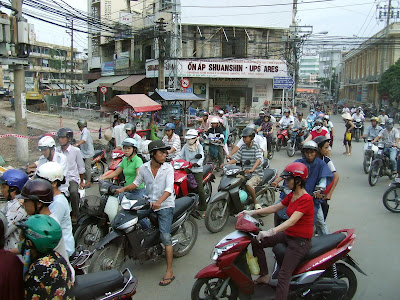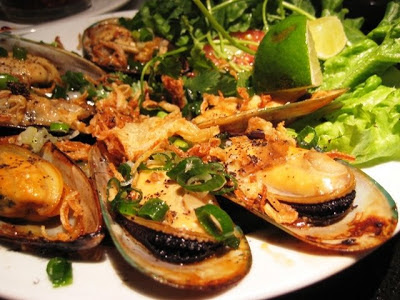Hidden in alcoves amidst the chaotic streets of Vietnam you'll find humble altars with a bundle of burning red incense, several pieces of fruit and a sprinkling of change. For the last 2,200 years the Vietnamese have stopped by these discrete places of worship to bow three times and offer donations to ensure their ancestors will protect their loved ones. It is believed that if one fails to engage in this ritual their dead relatives will become ma đói (hungry ghosts) with unsettled souls bringing bad luck.
The Vietnamese enact this practice daily in their homes, businesses and in public. Altars are visited during deaths, anniversaries, the opening of a family business, the failure to get pregnant...you name it. Depending upon the reason for the visit different gifts are offered to one or more of the thousands of gods and goddesses all of whom have designated purposes.
The New Year is Vietnam's most important holiday. The whole country shuts down for over a month as people return to their hometowns to spend time with family. Preparation begins two to three weeks before the official day with stocking up on food, buying new clothes, cleaning the house and decorating. From the expansive rice paddies of the countryside to the packed corridors of Hanoi, you'll find banners of rainbow flags draped across buildings, canopies of lanterns dangling over streets and specially grown good luck kumquat trees resting in pots.
No where can the festivity of the New Year be seen more than in the city of Hoi An. One string of lanterns hangs after the next painting a rainbow zig zag pattern into the sky that glows when the sun sets.
The center of town can be circled in about twenty minutes. It's divided by a small river that's connected by two short bridges engraved with traditional Chinese designs and lining the water sits french-influenced, dijon-colored restaurants and shops. The charming aesthetic has turned Hoi An into a tourist destination. You'll see more foreigners than Vietnamese women in conical hats riding around on bicycles, but the spirtuality prevails. The red bamboo incense lit to scare away evil are stuck into dirt along sidewalks, temples on every street are filled with locals meditating and as it begins to get dark hundreds of floating candles are pushed out into the river for the New Year.

Despite the commitment to these traditions, in the most recent census 81% of the Vietnamese population said they are atheist. For the people of Vietnam engaging in these practices is not about individual religiousity, it is about devotion to the well-being of their families and country. Their daily trips to the altars are always centered around the prosperity of relatives and fellow citizens. Their one month off to celebrate the New Year encourages familial and national unity as together the Vietnamese engage in a long process towards blessing one another with health and happiness.

The noise and pollution of Vietnam can be overwhelming for a visitor. If coming from a country with road rules, even trying to navigate down the paths crowded with locals chatting on plastic stools or crossing the street as motorbikes with food stalls strapped to the back swerve around pedestrians can be a challenge. If ever looking for respite from the hustle and bustle, just walk behind the vendors, duck into any building and chances are you'll find a quiet courtyard with two or three Vietnamese holding incense and wishing their loved ones well.



















































